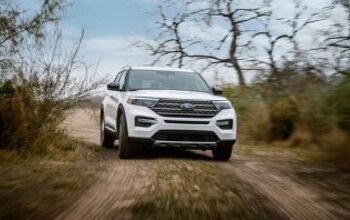Heavens! 16.7 Million Vehicles Sold In China?

In today’s wode tian (OMG) moment, China’s People’s Daily reports that “a total 16.7 million vehicles were sold in China last year, bringing the country’s total vehicles to more than 186 million.” Shen me? (Excuse me?)
Wode tian (OMG) moment “Around 41 percent of the vehicles were cars and 51 percent were motorcycles,” says People’s Daily. Jeez, does that mean that Chinese bought only 6.85m cars in 2009, half of the expected 13.5m? Take a deep breath. Bad translation. Should read “51 percent of the 186m vehicles are motorcycles.”
The numbers above were released by China’s Ministry of Public Security that handles vehicle registrations. Total numbers of Chinese car sales have yet to be announced by the China Association Of Automobile Manufacturers. Watch this space for the official announcement.
Interesting factoids: According to the Ministry’s statistics, 76m cars are on China’s roads. Taking the official Chinese population number of 1.3b at face value, then this comes down to 60 cars per thousand pop. A far cry from the more than 800 cars per thousand in the US, or the 500 cars per thousand in most developed countries. Think they’ll never drive more than a bicycle? Think again.
Almost 200 million Chinese can drive a vehicle, about 15 percent of the population. There are 138m holders of a driver’s license for a car, nearly twice the number of cars on the road. (In the US, there are some 200m licensed drivers, and some 250m registered cars.) About 19 million Chinese obtained a driver’s license in 2009.
The talks of a Chinese car bubble are bubbles in some peoples’ brains. China has taken the first baby steps to mass motorization. China has many decades of growth ahead of it.

Bertel Schmitt comes back to journalism after taking a 35 year break in advertising and marketing. He ran and owned advertising agencies in Duesseldorf, Germany, and New York City. Volkswagen A.G. was Bertel's most important corporate account. Schmitt's advertising and marketing career touched many corners of the industry with a special focus on automotive products and services. Since 2004, he lives in Japan and China with his wife <a href="http://www.tomokoandbertel.com"> Tomoko </a>. Bertel Schmitt is a founding board member of the <a href="http://www.offshoresuperseries.com"> Offshore Super Series </a>, an American offshore powerboat racing organization. He is co-owner of the racing team Typhoon.
More by Bertel Schmitt
Latest Car Reviews
Read moreLatest Product Reviews
Read moreRecent Comments
- Philip I love seeing these stories regarding concepts that I have vague memories of from collector magazines, books, etc (usually by the esteemed Richard Langworth who I credit for most of my car history knowledge!!!). On a tangent here, I remember reading Lee Iacocca's autobiography in the late 1980s, and being impressed, though on a second reading, my older and self realized why Henry Ford II must have found him irritating. He took credit for and boasted about everything successful being his alone, and sidestepped anything that was unsuccessful. Although a very interesting about some of the history of the US car industry from the 1950s through the 1980s, one needs to remind oneself of the subjective recounting in this book. Iacocca mentioned Henry II's motto "Never complain; never explain" which is basically the M.O. of the Royal Family, so few heard his side of the story. I first began to question Iacocca's rationale when he calls himself "The Father of the Mustang". He even said how so many people have taken credit for the Mustang that he would hate to be seen in public with the mother. To me, much of the Mustang's success needs to be credited to the DESIGNER Joe Oros. If the car did not have that iconic appearance, it wouldn't have become an icon. Of course accounting (making it affordable), marketing (identifying and understanding the car's market) and engineering (building a car from a Falcon base to meet the cost and marketing goals) were also instrumental, as well as Iacocca's leadership....but truth be told, I don't give him much credit at all. If he did it all, it would have looked as dowdy as a 1980s K-car. He simply did not grasp car style and design like a Bill Mitchell or John Delorean at GM. Hell, in the same book he claims credit for the Brougham era four-door Thunderbird with landau bars (ugh) and putting a "Rolls-Royce grille" on the Continental Mark III. Interesting ideas, but made the cars look chintzy, old-fashioned and pretentious. Dean Martin found them cool as "Matt Helm" in the late 1960s, but he was already well into middle age by then. It's hard not to laugh at these cartoon vehicles.
- Dwford The real crime is not bringing this EV to the US (along with the Jeep Avenger EV)
- Kwik_Shift_Pro4X Another Hyunkia'sis? 🙈
- SCE to AUX "Hyundai told us that perhaps he or she is a performance enthusiast who is EV hesitant."I'm not so sure. If you're 'EV hesitant', you're not going to jump into a $66k performance car for your first EV experience, especially with its compromised range. Unless this car is purchased as a weekend toy, which perhaps Hyundai is describing.Quite the opposite, I think this car is for a 2nd-time EV buyer (like me*) who understands what they're getting into. Even the Model 3 Performance is a less overt track star.*But since I have no interest in owning a performance car, this one wouldn't be for me. A heavily-discounted standard Ioniq 5 (or 6) would be fine.Tim - When you say the car is longer and wider, is that achieved with cladding changes, or metal (like the Raptor)?
- JMII I doubt Hyundai would spend the development costs without having some idea of a target buyer.As an occasional track rat myself I can't imagine such a buyer exists. Nearly $70k nets you a really good track toy especially on the used market. This seems like a bunch of gimmicks applied to a decent hot hatch EV that isn't going to impression anyone given its badge. Normally I'd cheer such a thing but it seems silly. Its almost like they made this just for fun. That is awesome and I appreciate it but given the small niche I gotta think the development time, money and effort should have been focused elsewhere. Something more mainstream? Or is this Hyundai's attempt at some kind of halo sports car?Also seems Hyundai never reviles sales targets so its hard to judge successful products in their line up. I wonder how brutal depreciation will be on these things. In two years at $40k this would a total hoot.So no active dampers on this model?


































Comments
Join the conversation
I’m guessing that Bertel, like most older business people working in China; knows a few spoken phrases, or maybe even many of them, but does not know written Chinese. It’s a lot more difficult to learn than say, French. Mostly because first, it’s a completely different writing system (not alphabetical), and secondly because it’s not even phonetic. Although he can probably get people to help him, it would just be inconvenient.
TTAC please don’t post all this PIN YIN. Instead, you should post Han Zi characters and back them up with Pin Yin inside parenthesis.
Anything else I can help you with? Low interest loan? Live-in ayi?